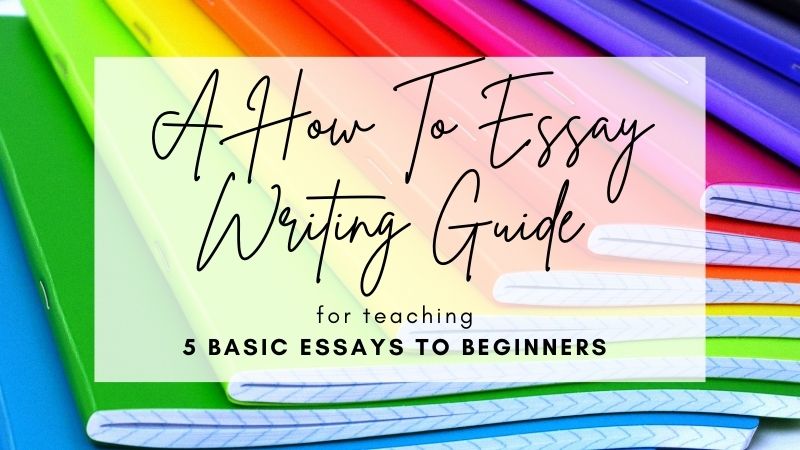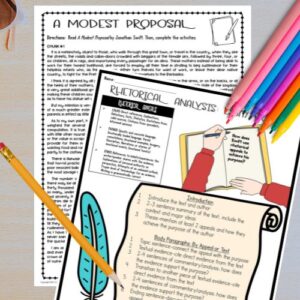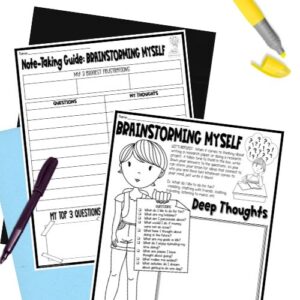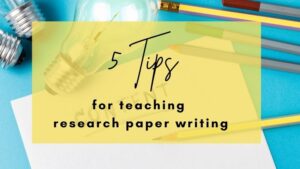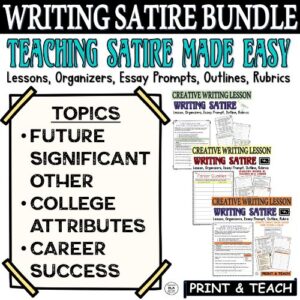Essay writing can be both the joy and the bane of an English teacher’s existence. The grading process for essays can be arduous for teachers but the opportunity to build students’ skills far outweighs that. Plus, the process of teaching and mastering the skills of writing any number of essay types can be made engaging and effective for a student audience. These reasons are why we need a how to essay writing guide for beginning writers!
There is a great deal of importance in being able to write essays and other genres in today’s society. Clear communication is a valuable skill in the classroom and just about every facet of life beyond the classroom too! And the value of writing essays is not just in the finished product but even more so in the process of brainstorming, outlining, writing, and then editing any type of essay.
This step-by-step process is key for teaching students how to write an essay. This approach to include a how to essay writing guide will help to scaffold the tasks thereby leading to greater chances of success.
Need help with test prep? Check out this FREE Pack of 3 Test Prep Activities to help students practice for standardized tests!

Define Essay Writing to Help with How To Essay Writing
Essay writing helps students to develop their ideas, explain the concepts and ideas of others, and to do so in writing develops skills in grammar and clear communication.
Continuing to include essay writing in high school English is integral because it develops a tremendous amount of skills that will serve students long after they leave our high school classrooms. While some students may never write a formal essay after graduation, they will still have a great set of skills that include the following as a part of using a how to essay writing guide:
- Writing with clarity
- Research
- Idea organization
- Critical thinking
- Using evidence and reasoning
- Proofreading and editing
To establish and hone these skills while keeping lessons fresh, there are a variety of essay writing types that teachers can use. Keep reading for five different options and a ton of tips for success when using a How To Essay Writing Guide!
Types of Essays & How To Essay Writing Steps
Narrative Essay Writing
A narrative essay tells a nonfiction story with a beginning, a middle, and an end. Narrative essays combine personal and creative writing. But, unlike a traditional essay, a narrative essay doesn’t need to have a specific thesis statement to be proven with evidence. There is still an overall purpose that is shared with the reader, which can be likened to a thesis.
Learning to write a narrative essay is important because it helps communication skills with a more personal focus. Additionally, it provides students the chance to develop creativity and imagination, which they will need throughout their lives!
Like most essays, a strong plan that includes the process of how to essay writing usually leads to a strong final product. From brainstorming a topic to the message of the essay, students can then write a rough draft ensuring they have a beginning, middle, and end to their story. In the revision process, the key to success is making sure to show and not just tell. This step is where students should focus on incorporating imagery to ‘paint the picture’ of the moment using figurative language devices.
A narrative essay can be small in scope like Virginia Woolf’s “Death of a Moth,” which recounts a very small moment in time where the writer witnesses the death of a moth. Other essays can be more impactful in their message such as “Self-Reliance” by Ralph Waldo Emerson, which examines one’s need to avoid conforming to the status quo.
More great sources for how to essay writing narratives are the New York Times’ annual Personal Narrative Essay Contest as well as this ready-made resource with an original narrative essay and guided questions for students to analyze the essay as a mentor text before writing their own nonfiction stories!

Expository Essay Writing
An expository essay shares factual information to explain a chosen topic objectively. There are several forms within this essay category including cause and effect, compare and contrast, process or how-to, descriptive, as well as problem and solution.
Since this form of essay is the most common in day-to-day use, it is important that students understand how to read and evaluate such writing. The best way to learn how to understand this form of essay is to write one from start to finish! This feat can easily be accomplished through a how to essay writing process!
Begin with brainstorming and choosing a topic based on the type of expository essay students will be writing – is it a how-to or a cause and effect? Then complete some research to make sure to include specific and factual information. Write an outline with an introduction, body paragraphs – 3 is common – and a conclusion. Use the outline to draft and revise before submitting a final copy for evaluation. If it’s a how-to essay, consider having someone attempt to follow the instructions to see what needs to be updated or changed.
One of the most effective and engaging options for this type of essay is to incorporate film. Using this no-prep resource, your students will examine how film techniques contribute to the purpose of any film! Use teacher-led examples to pre-write and organize ideas, fill in a template to create a thesis statement, and go sentence by sentence to outline and write essays.
Argumentative Essay Writing
An argumentative essay is one where students research a topic, evaluate the evidence, and write to convince an audience to agree with their stance on the chosen topic.
This essay form is important to learn because it involves both strong critical thinking and writing skills. Students must decide on a claim for their topic – what do they want to prove or convince an audience to agree with? This requires critical thinking about the right line of reasoning and the best logical choices of evidence and argumentation. With those choices made, students then need to communicate clearly.
After deciding on a topic, students should write out the pros and cons of their claim – a t-chart is ideal for this task. Deciding which side is stronger students can then develop a strong outline for their main points, with a focus on which order builds the best argument. Finally, as with every essay type, make use of all steps of the process from a rough draft through to editing a final copy.
To engage students, consider challenging them with a satirical example of an argumentative essay like Jonathan Swift’s “A Modest Proposal” from 1729. Another option, if you’re teaching higher-level learners, is to use as a whole or in parts Henry David Thoreau’s famous essay “On the Duty of Civil Disobedience” from 1849.
Rhetorical Analysis Essay Writing
A rhetorical analysis essay examines the essay as a sum of its parts. This means examining the use of rhetoric and appeals (pathos, logos, ethos) to persuade, inform, or entertain an audience.
Learning how to effectively persuade someone using rhetorical tools is a skill that can be used in a variety of ways beyond the classroom and long into the future so this type of essay is worth giving some time in your classroom.
To write a persuasive essay, you can start by reading some mentor texts. Students can examine the use of rhetoric to learn how they can use it in their own writing.
With this type of essay, encourage students to draft a wide variety of points for support sorting them according to the three types of appeals: pathos, logos, and ethos. Once students see all of their options they can decide which is best. This type of essay also benefits a great deal from a session of peer-to-peer draft reading. Other students can evaluate if they might be convinced by the students’ reasons and then offer a different perspective to help solidify or diversify the content.
Check out this rhetorical analysis bundle to help students create thesis statements, outline essays, examine nonfiction texts, write short responses, and analyze rhetorical appeals!!
Click below to read more about How to Essay Writing for Rhetorical Analysis!
Research Essay Writing
A research essay is, as the name implies, an essay that includes solid research of primary and secondary sources. This type of essay provides evidence and in-depth analysis as well as interpretation and evaluation of that evidence.
The best advice for this essay type is to choose a topic that is of interest since students will spend a long time with the subject through the research, evaluation and interpretation, and writing processes. As always, a solid outline will aid in the success of writing a research essay. Moreover, ensuring the use of well-considered and reliable information from a variety of sources will strengthen the content presented in the final product.
To support students in their research use this digital brainstorming and planning resource for research papers in middle school and high school.
Want some more how to essay writing help for Research Papers? Click below!
Some Final Thoughts on How To Essay Writing
There are tons of reasons to teach essay writing! For students, the most relevant reasons relate to how skills can be used in “real life” beyond high school.
Sharing that the skills students learn through essay writing are adaptable is central.
Here are just a few ways essay writing can help in real life:
- If you can write a strong persuasive essay, then you could use those skills to persuade someone to give you a job or a raise.
- If you can write a strong research essay, you can make sound financial decisions about the best types of investments to make or cars to buy.
- If you can write a strong narrative essay, you are well on your way with college and scholarship applications.
In short, knowing how to write essays is relevant today because it involves a wide variety of adaptable skills! And including a how to essay writing guide to help students is the first step in mastering writing!
Need a how to essay writing guide for satirical essays? Check out my store Kristin Menke-Integrated ELA Test Prep!

